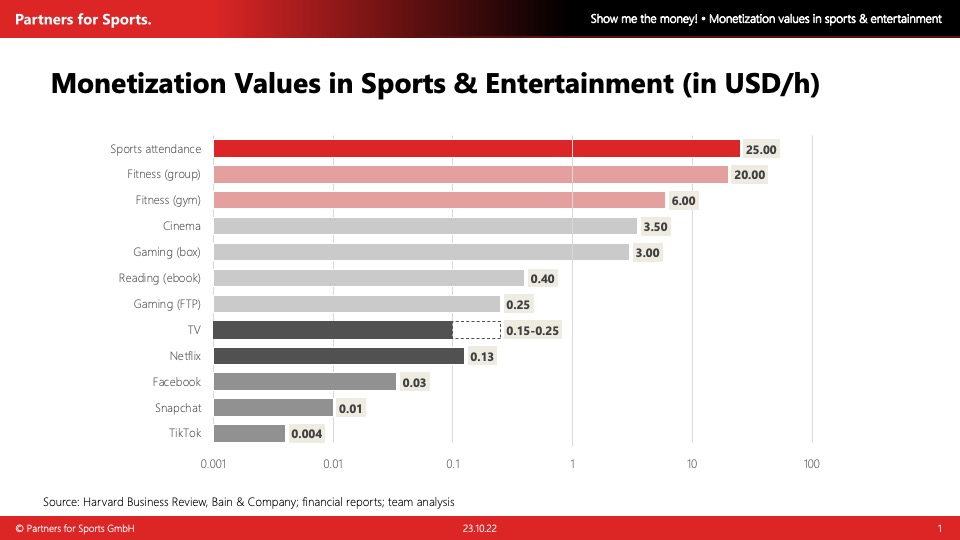Monetizing sports events has been a priority since their inception but has always been challenging. The transformation of sports through changed user behavior and new media accentuates this challenge. Modern consumers expect more and more services to be free, and their attention span is ever decreasing.
In a previous blog post, we proposed the I=DEM model to help think about estimating and evaluating the income from sports, in fact, every activity. A critical variable in this equation is the “M,” which stands for monetization. As a quick reminder, M denotes the income earned over a unit of time, typically an hour, directly or indirectly, per user or consumer. Therefore, a deeper examination of this variable is essential and, at the same time, opens up enlightening insights.
We want to illustrate this with a simple example. The average price of a cinema ticket worldwide is around $7. The average length of a film has increased in recent years and is currently a little under 2 hours. Therefore, the pleasure of watching a movie in the dark on a big screen with a decent sound system is worth about $3.5 an hour to us.
Monetization in Media & Entertainment
How does this relate to the price we pay for watching a movie on a streaming service or spending an hour on a social media platform? We have determined values for M for various activities and compiled them in the graphic below. However, we want to emphasize that collecting these values is sometimes only possible with considerable effort and is inherently imprecise. Moreover, we doubt whether companies in said fields even have accurate data. Nevertheless, consideration and comparison are possible with little reservations.

It is immediately apparent that we are willing to spend the most money on activities in person with a particular element of limitation and exclusivity. So much so that VIP event attendees are eager to spend thousands of dollars an hour. However, this can also be transferred to fitness classes in which a group of amateur athletes, under the direction of an instructor, do sweat-inducing activities such as cycling, fitness, or boxing.
Leveraging media removes limitations of time and space, but at the cost of losing immediacy. This loss reflects itself in the fact that the monetization for TV consumption, reading books, or gaming, for example, is an order of magnitude lower. At the same time, we must keep in mind that the business model for these activities differs. For example, consumer engagement is often no longer monetized directly but indirectly via advertising or affiliation sales. This shift leads to inevitable leakage in monetization but can be compensated for by the much higher number of users.
Monetization on social platforms loses another order of magnitude, although their more traditional representatives still have a comparatively high value. TikTok, in particular, has (currently) a very low monetization, but this may change in the future.
Why does this matter?
Young people, in particular, are spending more and more time on social media. In addition to the short formats, the low level of monetization poses a problem for many sports organizations. Today’s essential task of sports organizations is to reach consumers through social media and, through appropriate means, bring them to activities where monetization is higher. Stay tuned for later blog posts to find out what these means are.
